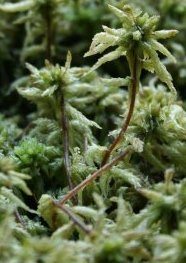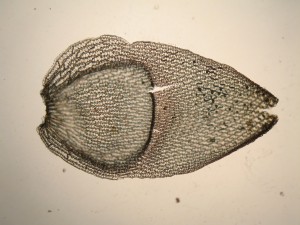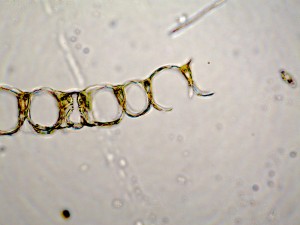Habitat
Sphagnum palustre is a dioicous species that can be found in various habitats, but most commonly they form round, well-drained mounds in bog margins. At times, they can also live in areas near watercourses or on damp ledges. They have a wide distribution in all continents with the exception of Antarctica.
Gametophyte
Overall structure:
S. palustre can vary in color, ranging from pale green to golden-green, at times the gametophyte can be tinged with pink or brown. The plants are typically tall to moderately-sized and form turfs that are either closely or loosely packed. The capitulum is often rounded and compact, but sometimes can be flattened.
Stem:
The stem of this species is dark green to brown in color.
The reinforcing fibrils can be seen on the cortical cells and the hyaline cells may have two-four pores per cell.
Stem leaves:
These leaves can occasionally be longer than other leaves and the hyaline cells are not ornamented nor are they divided. Furthermore, the leaves on the stem tend to be oblong-ligulate in shape and have a rounded tip.
Branch fascicle:
S. palustre has two to three divergent and two pendent branches per fascicle. The branches of this species are long and taper.
Branch stem:
The hyaline cells of the branch stem are not ornamented and often have one large pore.
Branch leaves:
One of the key distinguishing characteristics of this species are the branch leaves. The divergent branches are typically swollen and the leaves are incurved and inflated. Moreover, the leaves overlap each other, they have a rounded tip and are broadly ovate in shape.
A closer look at a branch leaf cross section will demonstrate that the chlorophyllose cells are triangular to ovate-triangular in shape and are not completely enclosed. As seen in this picture, the chlorophyllose cells are more broadly exposed to the concave surface.
Sporophyte
Overall structure:
The sporophyte of S. palustre, with its numerous pseudostomata, are infrequent and tend to mature in the summer.
Spores:
The surface of the spores can be either smooth or have fine papillae.






